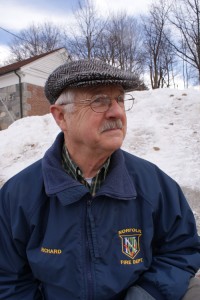Nemo Dumped a Pile of Snow But Never Matched the Hype
Norfolk’s roads cleared within 38 hours
By Lloyd Garrison
Like Hurricane Sandy, the winter storm named Nemo was tracked several days in advance and prompted some forecasters to predict a “storm of the century.” Unlike Sandy, its full impact was limited to coastal areas and eastern Connecticut. A record 40 inches of snow fell in Hamden, a New Haven suburb.
“It was a big storm,” says Russell Russ, who oversees the official Weather Service station in Great Mountain Forest. “But it wasn’t crazy big. We recorded 17.2 inches.”
Nemo, the name given the storm by the Weather Channel, struck Norfolk the night of Friday, Feb. 9. It was marked by intense snow bursts that showed up as dark blue streaks on the weather radar. Russ likened it to a thunderstorm that dumps a half inch of rain one place and two inches just down the road.
According to Russ, a weather station run by Harry White on Sandy Brook Road in Colebrook recorded a depth of 28 inches while the center of town got only 18 inches.
Norfolk Town Foreman John Allyn reports that his six drivers frequently encountered two foot depths and wind-blown snow of up to five feet. “I have never seen such intensity in a snowstorm,” he says. “Around 11 p.m. on Friday the wind was blowing a steady 20 with gusts over 50 miles per hour, and snow was falling at a rate of four to six inches an hour.”
Visibility was so bad Allyn had to call in his plows until the snow let up shortly after daybreak on Feb. 10. But 38 hours later his crews had cleared all of Norfolk’s 56 miles of roads, although roadside drifts created by plowing sometimes limited driving to one lane.
Greg Naylor, Norfolk’s Resident State Trooper, responded to two vehicles on 272 that spun off the turn in the road by the entrance to Dennis Hill. “Both cars were pulled free and attended to by George’s Garage,” he says.
Normally in such extreme weather, First Selectman Sue Dyer would coordinate the town’s response from her office in Town Hall. With Dyer on the Cape for a curling event, Richard Byrne took over.
Byrne, who was snowed in, posted news about the storm on Norfolk’s Emergency Management Web site from his home. Because Litchfield County was spared the massive power outages wrought by Sandy, Byrne could take part in conference calls linking municipalities to the state emergency operating center in Hartford. He posted the Governor’s order banning all vehicles from using public roads until 4 p.m. Saturday, a move that Allyn said was a big help in speeding road clearance.
Byrne, the town’s emergency management director, was snowed in. He was soon on the phone and in e-mail contact with his public information officer, Jon Barbagallo, a veteran of the Norfolk Volunteer Fire Department. Working from his house as well, Barbagallo fed up-to-date information to the system’s Web site.
With Litchfield County spared the massive power outages wrought by Sandy, Byrne could take part in conference calls linking municipalities to the state emergency operating center in Hartford. Barbagallo posted news direct from the center along with the governor’s order banning all vehicles from using public roads until 4 p.m. Saturday. According to Allyn, the governor’s decision was a big help in speeding snow removal.


